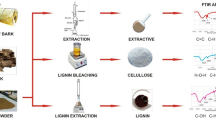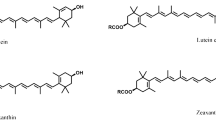Abstract
In addition to lignin, grass cell walls are characterized by the presence of hydroxycinnamic acids that play a significant role in cross-linking polymers into a cohesive network, and pretreatments are required to overcome the recalcitrance of lignocelluloses prior to enzymatic bioconversion of polysaccharides. The effects of dilute acid and ammonium hydroxide pretreatments were studied on the chemical composition and enzymatic saccharification of Miscanthus internodes fragments. The hydroxycinnamic acid content was reduced after both pretreatments, while lignin got enriched in condensed linked structures. In addition, dilute acid pretreatment was effective in decreasing xylan content of Miscanthus, while ammonia treatment induced a marked swelling effect on the cell walls of parenchyma, vascular sclerenchyma, and epidermal sclerenchyma. The phenol distribution at the cell level was estimated using UV transmission microspectrophotometry. Internode cell walls displayed different UV spectra according to the cell type. However, the secondary cell walls had similar UV spectra after pretreatment, whereas spectra recorded at the cell corner region displayed variations according to cell type and pretreatment. Acid pretreatment was more efficient than ammonia to improve the conversion of polysaccharides by a Trichoderma cellulolytic cocktail. Although pretreatments achieved moderate saccharification yields, the secondary cell walls were altered at some pit regions of the vascular sclerenchyma whereas parenchyma appeared recalcitrant. Variations in the UV spectra of enzyme-digested cell walls suggest pretreatment-dependent heterogeneity of the phenolic distribution in the more recalcitrant cell walls.








Similar content being viewed by others
References
Himmel ME, Ding S-Y, Johnson DK, Adney WS, Nimlos MR, Brady JW et al (2007) Biomass recalcitrance: engineering plants and enzymes for biofuels production. Science 315(5813):804–807. doi:10.1126/science.1137016
Ragauskas AJ, Williams CK, Davison BH, Britovsek G, Cairney J, Eckert CA et al (2006) The path forward for biofuels and biomaterials. Science 311(5760):484–489. doi:10.1126/science.1114736
Rubin EM (2008) Genomics of cellulosic biofuels. Nature 454(7206):841–845. doi:10.1038/nature07190
Sánchez ÓJ, Cardona CA (2008) Trends in biotechnological production of fuel ethanol from different feedstocks. Bioresour Technol 99(13):5270–5295. doi:10.1016/j.biortech.2007.11.013
Orts WJ, Holtman KM, Seiber JN (2008) Agricultural chemistry and bioenergy. J Agric Food Chem 56(11):3892–3899. doi:10.1021/jf8006695
Schmer MR, Vogel KP, Mitchell RB, Perrin RK (2008) Net energy of cellulosic ethanol from switchgrass. Proc Natl Acad Sci 105(2):464–469. doi:10.1073/pnas.0704767105
Tilman D, Hill J, Lehman C (2006) Carbon-negative biofuels from low-input high-diversity grassland biomass. Science 314(5805):1598–1600. doi:10.1126/science.1133306
Heaton EA, Long SP, Voigt TB, Jones MB, Clifton-Brown J (2004) Miscanthus for renewable energy generation: European Union experience and projections for Illinois. Mitig Adapt Strateg Glob Chang 9(4):433–451. doi:10.1023/B:MITI.0000038848.94134.be
Lewandowski I, Clifton-Brown JC, Scurlock JMO, Huisman W (2000) Miscanthus: European experience with a novel energy crop. Biomass Bioenergy 19(4):209–227
Anderson E, Arundale R, Maughan M, Oladeinde A, Wycislo A, Voigt T (2011) Growth and agronomy of Miscanthus × giganteus for biomass production. Biofuels 2(2):167–183. doi:doi:10.4155/bfs.10.80
Hodgson EM, Lister SJ, Bridgwater AV, Clifton-Brown J, Donnison IS (2010) Genotypic and environmentally derived variation in the cell wall composition of Miscanthus in relation to its use as a biomass feedstock. Biomass Bioenergy 34(5):652–660. doi:10.1016/j.biombioe.2010.01.008
Henrissat B, Teeri TT, Warren RAJ (1998) A scheme for designating enzymes that hydrolyse the polysaccharides in the cell walls of plants. FEBS Lett 425(2):352–354
Berlin A, Balakshin M, Gilkes N, Kadla J, Maximenko V, Kubo S et al (2006) Inhibition of cellulase, xylanase and β-glucosidase activities by softwood lignin preparations. J Biotechnol 125(2):198–209. doi:10.1016/j.jbiotec.2006.02.021
Yang B, Wyman CE (2004) Effect of xylan and lignin removal by batch and flowthrough pretreatment on the enzymatic digestibility of corn stover cellulose. Biotechnol Bioeng 86(1):88–98. doi:10.1002/bit.20043
Iiyama K, Lam TBT, Stone BA (1990) Phenolic acid bridges between polysaccharides and lignin in wheat internodes. Phytochemistry 29(3):733–737. doi:10.1016/0031-9422(90)80009-6
Terashima N, Fukushima K, He L-F, Takabe K (1993) Comprehensive model of the lignified plant cell wall. ASA-CSSA-SSSA, Madison
Ralph J (2010) Hydroxycinnamates in lignification. Phytochem Rev 9(1):65–83. doi:10.1007/s11101-009-9141-9
Hendriks ATWM, Zeeman G (2009) Pretreatments to enhance the digestibility of lignocellulosic biomass. Bioresour Technol 100(1):10–18. doi:10.1016/j.biortech.2008.05.027
Yang B, Wyman CE (2008) Pretreatment: the key to unlocking low-cost cellulosic ethanol. Biofuels, Bioprod Biorefin 2(1):26–40. doi:10.1002/bbb.49
Kumar P, Barrett DM, Delwiche MJ, Stroeve P (2009) Methods for pretreatment of lignocellulosic biomass for efficient hydrolysis and biofuel production. Ind Eng Chem Res 48(8):3713–3729. doi:10.1021/ie801542g
Mosier N, Wyman C, Dale B, Elander R, Lee YY, Holtzapple M et al (2005) Features of promising technologies for pretreatment of lignocellulosic biomass. Bioresour Technol 96(6):673–686. doi:10.1016/j.biortech.2004.06.025
Grohman K, Torge R, Himmel ME (1985) Optimization of dilute acid pretreatmentof biomass. Biotechnology and Bioengineering Symposium 15:59–80
Grohman K, Bothast R (1997) Saccharification of corn fibre by combined treatment with dilute sulphuric acid and enzymes. Process Biochem 32(5):405–415
Brosse N, Sannigrahi P, Ragauskas A (2009) Pretreatment of Miscanthus × giganteus using the ethanol organosolv process for ethanol production. Ind Eng Chem Res 48(18):8328–8334. doi:10.1021/ie9006672
Kim TH, Lee YY (2005) Pretreatment and fractionation of corn stover by ammonia recycle percolation process. Bioresour Technol 96(18):2007–2013. doi:10.1016/j.biortech.2005.01.015
Le Ngoc Huyen T, Rémond C, Dheilly RM, Chabbert B (2010) Effect of harvesting date on the composition and saccharification of Miscanthus × giganteus. Bioresour Technol 101(21):8224–8231. doi:10.1016/j.biortech.2010.05.087
Murnen HK, Balan V, Chundawat SPS, Bals B, Sousa LDC, Dale BE (2007) Optimization of ammonia fiber expansion (AFEX) pretreatment and enzymatic hydrolysis of Miscanthus × giganteus to fermentable sugars. Biotechnol Prog 23(4):846–850. doi:10.1021/bp070098m
Anderson W, Akin D (2008) Structural and chemical properties of grass lignocelluloses related to conversion for biofuels. J Ind Microbiol Biotechnol 35(5):355–366. doi:10.1007/s10295-007-0291-8
Wilson JR, Hatfield RD (1997) Structural and chemical changes of cell wall types during stem development: consequences for fibre degradation by rumen microflora. Aust J Agric Res 48(2):165–180, http://dx.doi.org/10.1071/A96051
Akin DE (2008) Plant cell wall aromatics: influence on degradation of biomass. Biofuels, Bioprod Biorefin 2(4):288–303. doi:10.1002/bbb.76
Koch G, Kleist G (2001) Application of scanning UV microspectrophotometry to localise lignins and phenolic extractives in plant cell walls. Holzforschung 55(6):563–567. doi:10.1515/hf.2001.091
Goto M, Takabe K, Abe I (1998) Histochemistry and UV-microspectrometry of cell walls of untreated and ammonia-treated barley straw. Can J Plant Sc 78(3):437–443. doi:doi:10.4141/P97-013
Yoshinaga A, Wada A, Fujita M, Chabbert B, Pilate G (2007) Modified lignification in the cell walls of CAD depressed poplars. IAWA J 48(4):457–471
Siqueira G, Milagres A, Carvalho W, Koch G, Ferraz A (2011) Topochemical distribution of lignin and hydroxycinnamic acids in sugar-cane cell walls and its correlation with the enzymatic hydrolysis of polysaccharides. Biotechnol Biofuels 4(1):7. doi:10.1186/1754-6834-4-7
Amougou N, Bertrand I, Machet J-M, Recous S (2011) Quality and decomposition in soil of rhizome, root and senescent leaf from Miscanthus × giganteus, as affected by harvest date and N fertilization. Plant Soil 338(1):83–97. doi:10.1007/s11104-010-0443-x
Rémond C, Aubry N, Crônier D, Noël S, Martel F, Roge B et al (2010) Combination of ammonia and xylanase pretreatments: Impact on enzymatic xylan and cellulose recovery from wheat straw. Bioresour Technol 101(17):6712–6717. doi:10.1016/j.biortech.2010.03.115
Iiyama K, Wallis AFA (1988) An improved acetyl bromide procedure for determining lignin in woods and wood pulps. Wood Sci Technol 22(3):271–280. doi:10.1007/bf00386022
Lapierre C, Monties B, Rolando C (1986) Thioacidolysis of poplar lignins—identification of monomeric syringyl products and characterization of guaicyl-syringyl lignin fractions. Holzforschung 40(2):113–118. doi:10.1515/hfsg.1986.40.2.113
Beaugrand J, Crônier D, Thiebeau P, Schreiber L, Debeire P, Chabbert B (2004) Structure, chemical composition, and xylanase degradation of external layers isolated from developing wheat grain. J Agric Food Chem 52(23):7108–7117. doi:10.1021/jf049529w
Durand H, Soucaille P, Tiraby G (1984) Comparative study of cellulases and hemicellulases from four fungi: mesophiles Trichoderma reesi and Penicillium sp. and thermophiles Thievalia terrestris and Sporotrichum cellulophilum. Enzym Microb Technol 6(4):175–180. doi:10.1016/0141-0229(84)90027-9
Herpoel-Gimbert I, Margeot A, Dolla A, Jan G, Molle D, Lignon S et al (2008) Comparative secretome analyses of two Trichoderma reesei RUT-C30 and CL847 hypersecretory strains. Biotechnol Biofuels 1. doi:1810.1186/1754-6834-1-18
Goldschmid O (1971) Ultraviolet spectra. In: Sarkanen KV, Ludwig CH (eds) Lignins occurence, formation, structure and reactions. Whiley-Interscience, New York, pp 241–266
Vidal B, Dien B, Ting K, Singh V (2011) Influence of feedstock particle size on lignocellulose conversion—a review. Appl Biochem Biotechnol 164(8):1405–1421. doi:10.1007/s12010-011-9221-3
Pingali SV, Urban VS, Heller WT, McGaughey J, O’Neill H, Foston M et al (2010) Breakdown of cell wall nanostructure in dilute acid pretreated biomass. Biomacromolecules 11(9):2329–2335. doi:10.1021/bm100455h
Isci A, Himmelsbach J, Pometto A, Raman D, Anex R (2008) Aqueous ammonia soaking of switchgrass followed by simultaneous saccharification and fermentation. Appl Biochem Biotechnol 144(1):69–77. doi:10.1007/s12010-007-8008-z
Kim TH, Nghiem NP, Hicks KB (2009) Pretreatment and fractionation of corn stover by soaking in ethanol and aqueous ammonia. Appl Biochem Biotechnol 153(1–2):171–179. doi:10.1007/s12010-009-8524-0
Zeng M, Ximenes E, Ladisch MR, Mosier NS, Vermerris W, Huang C-P et al (2012) Tissue-specific biomass recalcitrance in corn stover pretreated with liquid hot-water: enzymatic hydrolysis (part 1). Biotechnol Bioeng 109(2):390–397. doi:10.1002/bit.23337
Qing Q, Yang B, Wyman CE (2010) Xylooligomers are strong inhibitors of cellulose hydrolysis by enzymes. Bioresour Technol 101(24):9624–9630. doi:10.1016/j.biortech.2010.06.137
Buranov AU, Mazza G (2008) Lignin in straw of herbaceous crops. Ind Crop Prod 28(3):237–259. doi:10.1016/j.indcrop. 2008.03.008
Sannigrahi P, Pu Y, Ragauskas A (2010) Cellulosic biorefineries—unleashing lignin opportunities. Current Opinion in Environmental Sustainability 2(5–6):383–393. doi:10.1016/j.carres.2010.02.010
Hallac BB, Ray M, Murphy RJ, Ragauskas AJ (2010) Correlation between anatomical characteristics of ethanol organosolv pretreated Buddleja davidii and its enzymatic conversion to glucose. Biotechnol Bioeng 107(5):795–801. doi:10.1002/bit.22884
Chundawat SPS, Donohoe BS, da Costa Sousa L, Elder T, Agarwal UP, Lu F et al (2011) Multi-scale visualization and characterization of lignocellulosic plant cell wall deconstruction during thermochemical pretreatment. Energy Environ Sci 4(3):973–984. doi:10.1039/c0ee00574f
Lopez S, Murison SD, Travis AJ, Chesson A (1993) Degradability of parenchyma and sclerenchyma cell walls isolated at different developmental stages from a newly extended maize internode. Acta Botanica Neerlandica 42(2):165–174
Dresbøll DB, Magid J (2006) Structural changes of plant residues during decomposition in a compost environment. Bioresour Technol 97(8):973–981. doi:10.1016/j.biortech.2005.05.003
Zeng M, Ximenes E, Ladisch MR, Mosier NS, Vermerris W, Huang C-P et al (2012) Tissue-specific biomass recalcitrance in corn stover pretreated with liquid hot-water: SEM imaging (part 2). Biotechnol Bioeng 109(2):398–404. doi:10.1002/bit.23335
Chesson A, Provan GJ, Russell W, Scobbie L, Chabbert B, Monties B (1997) Characterisation of lignin from parenchyma and sclerenchyma cell walls of the maize internode. J Sci Food Agric 73(1):10–16. doi:10.1002/(sici)1097-0010(199701)73:1<10::aid-jsfa697>3.0.co;2-e
Day A, Ruel K, Neutelings G, Crônier D, David H, Hawkins et al (2005) Lignification in the flax stem: evidence for an unusual lignin in bast fibers. Planta 222:234–245. doi:10.1007/s00425-005-1537-1
Acknowledgments
The authors gratefully acknowledge TUCK foundation (ENERBIO funds) for the financial support of the PhD position of Belmokhtar Nassim. We are also grateful to Crônier D. and Mison T. for technical assistance.
Author information
Authors and Affiliations
Corresponding author
Rights and permissions
About this article
Cite this article
Belmokhtar, N., Habrant, A., Lopes Ferreira, N. et al. Changes in Phenolics Distribution After Chemical Pretreatment and Enzymatic Conversion of Miscanthus × giganteus Internode. Bioenerg. Res. 6, 506–518 (2013). https://doi.org/10.1007/s12155-012-9275-2
Published:
Issue Date:
DOI: https://doi.org/10.1007/s12155-012-9275-2




